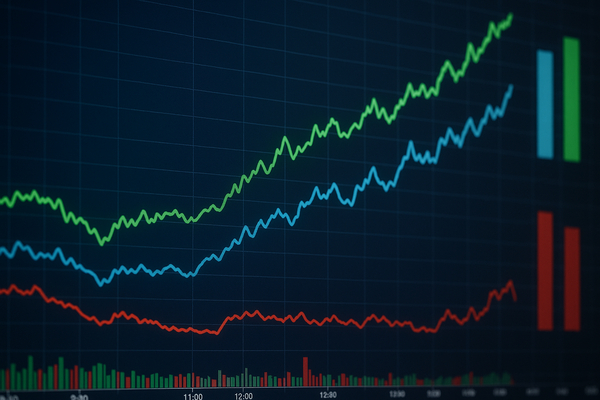
Stocks rally after trade rhetoric cools. Global equities recovered strongly as U.S. political signals eased fears of a large scale trade conflict with China. Tech names led gains in the short term as investors bought back positions sold on Friday. In the near term this can lift risk appetite and reopen the earnings window. Over the long term this reduces tail risk for growth sectors while keeping trade policy on watch for policy shocks. The move matters for the United States, Europe and Asia because it affects trade flows, currencies and commodity demand. The rebound follows a sharp sell off last week and reflects both policy repricing and renewed hopes for a leaders meeting later this month.
Market snapshot
Late session bounce restores risk appetite
Major U.S. indexes staged a clear recovery. The S&P 500 climbed about 1.6 percent in late trade and the Nasdaq rose roughly 2.2 percent. Chipmakers outperformed after Broadcom NASDAQ:AVGO and other semiconductors drew renewed buying pressure. Information Technology was the top performing S&P 500 sector, followed by Consumer Discretionary.
Currencies reflected the risk move. The U.S. dollar steadied after the change in tone, while the euro and yen weakened on separate political developments in France and Japan. Oil prices rebounded from a five month low as market participants priced in a possible thaw in U.S. China relations. Bond markets were closed for Columbus Day and Indigenous Peoples Day, leaving fixed income volumes light and yielding less immediate market signals.
Cryptocurrency markets remained volatile after a large liquidation event on Friday. Market participants estimated more than $19 billion of leveraged positions were wiped out. On Monday Bitcoin was trading near $114,375.22 and ether near $4,120.42 as leveraged traders adjusted exposures.
Drivers and market reaction
Trade rhetoric, safe havens, and commodity flows
President Donald Trump struck a more conciliatory tone on trade late in the session. Treasury Secretary Scott Bessent said the president was on track to meet Chinese President Xi Jinping in South Korea later this month. That announcement drove a surge in buying and helped reverse Friday’s steep declines.
Gold benefited as a safe haven trade. Bullion rose above $4,100 an ounce for the first time, and silver hit a record above $52 an ounce. Traders cited a mix of trade risk and expectations for further Fed easing as reasons for strong demand. Central bank purchases and ETF inflows were also cited as supporting the price rally.
Oil moved higher after hitting multi month lows last week. The prospect of renewed discussions between U.S. and Chinese leaders supported crude. At the same time, geopolitical headlines and demand expectations reinforced the recovery in energy markets.
Earnings and policy calendar
Banks open earnings season as traders hunt for macro cues
Tuesday opens the third quarter reporting cycle for the biggest U.S. banks. JPMorgan Chase NYSE:JPM, Goldman Sachs NYSE:GS, Citigroup NYSE:C and Wells Fargo NYSE:WFC are set to release results. These reports will set a tone for financials and provide fresh data on credit trends, trading revenue and corporate activity for the quarter.
Federal Reserve Chair Jerome Powell will speak in Philadelphia on economic conditions and monetary policy. Given the government shutdown and holiday closures, many standard data releases remain delayed and the market is short on fresh macro readings. Powell’s comments will be parsed for the Fed’s view on growth, inflation and the path of policy when weeks of labor market and price data are missing from the calendar.
With earnings and the Fed both in focus, markets may react to forward looking commentary from banks and to any change in the Fed’s tone. That will influence equity rotations and the behavior of interest rate sensitive assets such as gold and long duration tech names.
Trading session outlook and risks
Sectors and headlines to watch during the session
Information Technology and Consumer Discretionary are likely to remain in focus after strong performance. Chipmakers led the rebound and semiconductor names will be watched for follow through. Financials will receive fresh attention when the large banks report results, with traders parsing trading volumes, loan loss provisions and deal pipelines.
Key risks include the possibility of renewed hardening in trade rhetoric, volatile currency moves linked to European and Japanese politics, and residual shock from last week’s crypto liquidation. Low bond market participation on holiday closures can amplify equity moves because price discovery in rates is limited. News on whether a U.S China leaders meeting remains scheduled later this month will be an immediate catalyst.
In addition to earnings and the Fed speech, traders will track oil prices for clues on demand, and safe haven flows into gold for indications of risk appetite. Short term, markets may continue to price relief if officials follow through on talks. Over the medium term, policy actions and fresh economic data will determine whether this rally holds or gives way to renewed volatility.
Watch for headline risk, earnings surprises from the majors, and any updates on trade meetings. Those elements will shape intraday patterns and determine whether the late session rebound broadens into a sustainable upswing.








